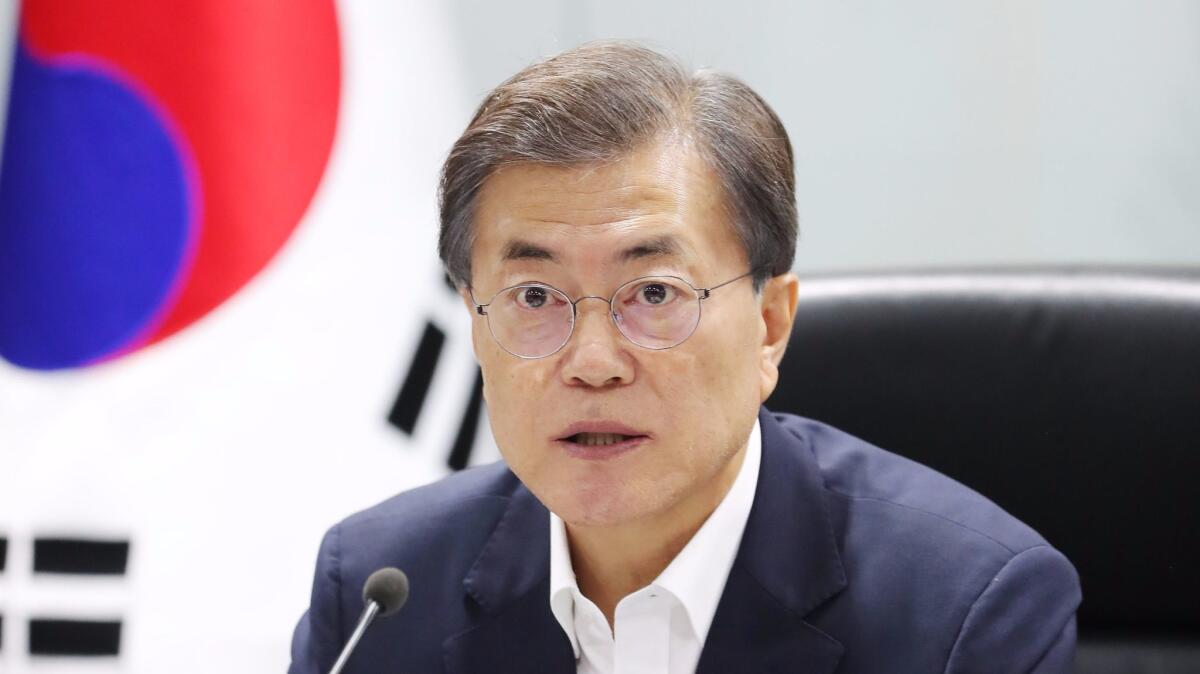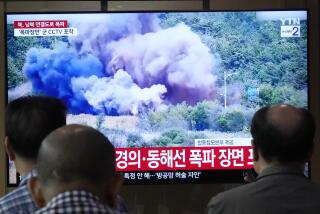South Koreans are surprisingly blase about civil defense. Why?

Reporting from SEOUL — At the highest levels in South Korea, the fiery rhetoric exchanged this week by Washington and Pyongyang over nuclear weapons has prompted extraordinary concern — even for a nation that’s been technically at war for several decades.
South Korea’s progressive new president, Moon Jae-in, on Wednesday called for a “rebirth” of his country’s defenses, telling military commanders that top-down reform was needed to counter North Korea’s escalating nuclear threats.
On the street, though, the most common reactions were shrugs that any conflict might affect residents’ safety.
“I have never thought a war would actually happen in my day, even though we are constantly threatened by North Korea,” said university student Han Hyo-jeong, 24, who met with friends Wednesday in Seoul’s Sinchon district, a central neighborhood known for its bustling nightlife.
Han is one of about 25 million residents — roughly half of South Korea’s population — who live in this capital city’s metropolitan area, within an hour’s drive or less of the highly secure North Korean border.
That proximity puts hundreds of thousands of residents within range of the North’s potentially catastrophic conventional weapons, such as artillery or rockets, should the war of words escalate to actual military conflict and the government in Pyongyang retaliate against fellow Koreans to the south.
But that threat of a war that might spill over onto the civilian population isn’t new — a fact that hasn’t changed amid the recent concern about the North’s effort to develop the capacity to deliver nuclear-armed intercontinental missiles to the U.S. mainland.
Meanwhile, the regional tensions, already high, were ratcheted up this week after the United States used long-range bombers over the Korean peninsula during a military exercise. North Korea, which has recently shown the ability to strike U.S. targets outside Northeast Asia with missiles, this week threatened to target Guam, a strategically located American territory in the Western Pacific from which the bombers were deployed.
The threat, delivered via North Korean state news, appeared to be prompted by President Trump’s declaration that “fire and fury” would come to the Pyongyang government if the threat to U.S. targets continued.
Any conflict, whether prompted by Pyongyang or Washington, could lead to catastrophic results in Seoul, the heart of Asia’s fourth-largest economy, despite some residents’ seeming lack of concern.
Even as many residents and tourists here enjoyed Wednesday without anxiety over the future, Trump’s comments seemed to escalate an already tense situation for South Korea’s leadership.
The renewed threats perhaps played a part in prompting Moon, who planned to seek a more conciliatory tone with North Korea after his election in May, to raise a new alarm about the escalating threat on the peninsula.
“I believe we might need a complete defense reform at the level of a rebirth instead of making some improvements or modifications,” Moon said Wednesday during a meeting with military commanders, according to pooled news reports.
He added, “Another task now facing us is the urgent task of securing defense capabilities to counter North Korea’s nuclear and missile provocations.”
The more serious situation, coming days after newly enacted United Nations sanctions prompted North Korea’s strong objections, also highlights the civil defense challenge in protecting Seoul’s residents.
The metro area’s residents are largely packed into densely populated neighborhoods, with some high-rise residential apartment complexes less than 45 miles from North Korea’s numerous artillery installations.
Both the national and metro governments have plans for dealing with a war, though it remains unclear how many residents are aware of them. The plans include a network of shelters — more than 3,000 in Seoul and even more nationwide — in subway stations, parking garages and other underground areas.
The government, which sends automatic warnings to cellphone users about low air-quality days, flash floods and abnormally high temperatures, offers an Internet application — in both English and Korean — for emergencies.
“In case of an emergency, the government will order us where to go and what to do,” said Choi Jin-soo, 29. “If we follow directions, we will be safe.”
Not everyone agrees.
James Kim, a research fellow at the Asan Institute in Seoul, said the city’s residents aren’t ready for an attack that some analysts believe could lead to tens of thousands of deaths within days.
“It’s not something that’s been drilled in. There isn’t a formal evacuation procedure,” said Kim, who has studied emergency management in South Korea. “There could be one in theory, but in terms of readiness, there’s isn’t enough preparation on the part of the Seoul city government or the national government so the people know what to do.”
Any conventional military strike on Seoul, regardless of efforts at readiness, could be deadly and disruptive, many fear. Yet not everyone here is buying that a threat would materialize, given that it would probably prompt a massive response by the United States.
“An unprovoked military attack against the United States or its treaty allies would be suicidal,” said Daniel Pinkston, an international relations expert at Troy University in Seoul. “The North Korean leadership is not suicidal.”
There’s also a cried-wolf sense here that the conventional North Korean threat might never actually happen, despite years of warnings.
North Korea, party to an unsteady armistice signed in the mid-1950s, has provoked international complaints over its actions, both related to military matters and human rights.
Current leader Kim Jong Un, grandson of the totalitarian state’s communist patriarch, Kim Il Sung, has increased the international provocations in recent years by developing nuclear weapons and testing missiles that could deliver them.
North Korea has conducted more than 50 ballistic missile tests during Kim’s tenure, which began in late 2011, and has also conducted two underground nuclear detonation tests — all violations of United Nations Security Council sanctions.
In a televised address in January, Kim also said his nation was making progress toward an intercontinental ballistic missile, a type capable of striking locations on the United States mainland.
President-elect Trump famously tweeted in January that such a step “won’t happen!”
Two recent missile tests confirmed that the North has acquired the ability, in theory, to meet that intercontinental goal — and concern has increased that the government has also miniaturized its nuclear devices to fit atop a missile.
Much of the world, in response, has expressed dire concern. Yet fear in Seoul is less palpable, almost inconceivable to many, even though the threats continue to raise alarm among local news organizations and the leadership.
“There can’t be a war,” said Jeong Jae-pyo, 58, who lives in Seoul. “We are always threatened, but there is never a war.”
Stiles is a special correspondent.
More to Read
Sign up for Essential California
The most important California stories and recommendations in your inbox every morning.
You may occasionally receive promotional content from the Los Angeles Times.











